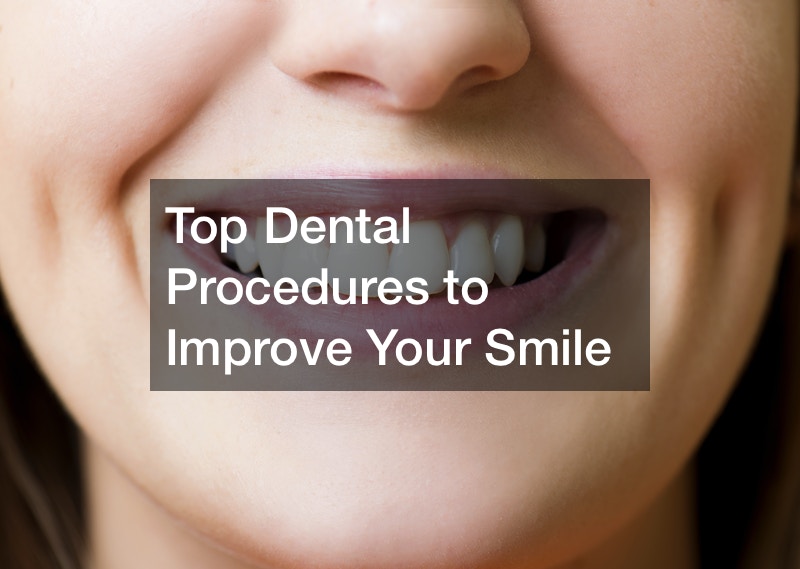

Dental Work is a very delicate surgery that only those properly trained should attempt to do. Your overall dental health can affect your overall well-being as it can bring an imbalance to your health insurance plans because you need teeth to eat and many other reasons. To ensure that you are getting the best dental work possible, visit the dentist regularly and consider taking up these top procedures.
Gum Therapy

Periodontal disease destroys gum tissue and leads to tooth loss. Gum disease also contributes to heart problems and diabetes by causing inflammation around blood vessels. Gum disease worsens if you do not practice good oral hygiene or follow professional advice from your dentist. The best way to treat this issue is through scaling, cleaning, and antibiotics. Gum disease is a serious issue that must be addressed before an infection develops.
If you do not practice good oral hygiene from general dentistry services, gum disease can lead to tooth loss and other significant problems. Scaling and root planing are necessary procedures that can be used to treat this type of condition by cleaning beneath the gum line. This process functions the same way as brushing teeth but at deeper levels to break down plaque buildup. An antiseptic will also be used to kill any bacteria found during scaling and root planning so that your body does not need to fight two battles at once.
Periodontal disease arises when plaque begins to build upon the teeth. This buildup occurs because some people do not practice good oral hygiene. If you can brush and floss your teeth regularly, this will greatly reduce or prevent periodontal disease from occurring at all. However, if you cannot follow through with healthy dental practices, then gum therapy may be necessary to treat this condition.
Root Planning is required when bacteria begin to grow on the tooth’s root due to plaque buildup. Root planing involves using special tools to remove part of the cementum layer on each tooth so that the root can be smoothed down once more. Filling any cracks or holes will also occur so that new bacteria does not have places on which it can collect. This procedure must be repeated every few months for two to three years if your dental health is poor.
Teeth Whitening

You may notice that your teeth become darker over time because of various reasons such as age, smoking habits, and even coffee drinking. If you want to get rid of the yellow stains that discolor your teeth, consider whitening them by using a bleaching agent that you can buy from your dentist or a professional at a dental office. However, you should be cautious if you have recently had dental implant surgery or experienced trauma on your mouth because doing this process incorrectly can cause gum damage.
If you want a whiter smile, your dentist can help improve the color of your teeth by applying a whitening agent to them. Your dentist may use various whitening agents, such as hydrogen peroxide, carbamide peroxide, or even alternative ingredients such as baking soda and water. These treatments usually take around an hour since they involve bleaching your teeth to remove stains on them caused by foods and drinks that you regularly consume over time.
Many people experience sensitivity from having their teeth whitened, but it should go away once their teeth restore themselves to normal after a few days or weeks of treatment, depending on how dark their enamel was before getting it done. To gain a whiter smile, your dentist can set you up with a whitening agent which will remove the stains on your teeth caused by certain foods and drinks.
This treatment usually takes an hour because it involves placing a bleaching agent onto each tooth to remove the yellow color from them that accumulates over time. Some people experience sensitive gums after having these procedures done, but this should go away in a few days or weeks, depending on how dark their enamel was before getting it done.
Root Canal Treatment

Some people may think getting a root canal is an excruciatingly painful procedure, but it is not as bad as some people say. A root canal is required if you experience severe tooth pain, sensitivity to temperature changes, or hot and cold food. Getting treatment is not as scary as it seems because your dentist will first numb your gums before he can remove any decayed or dying tissue from within the tooth. The pulp is then removed with tiny tools, and the empty chamber is cleaned out to be filled with an inert material called guttapercha.
Your tooth will then be restored to its original shape, and the process is complete. When the pulp inside your tooth falls victim to an infection, it must be treated immediately. If you ignore the problem, it can travel through your bloodstream to other vital organs, thus becoming life-threatening. The restorative dentistry service starts with numbing the area around your tooth before removing the diseased tissue that has caused the problem. The space is then filled with an inert substance to kill lingering bacteria and promote natural healing.
Finally, the tooth is restored to its original form to make it look as good as new. However, suppose you are suffering from a chronic infection in your mouth. In that case, your dentist may recommend using non-vital root canal therapy, which relies on chemicals to remove any infectious material accumulated within your teeth. You can also receive endodontic treatment for non-vital pulp therapy to resolve an injury or accident which has caused the damage. If you have a problem with a decayed or dying tooth, a root canal can be used to remove any infected tissues from within your mouth and then replace them with inert materials that will help your mouth heal naturally.
Your dentist may use various root canal procedures to resolve infection problems and damaged tooth repair with the pulp tissue inside your tooth, including vital and non-vital treatments. Vital root canals remove infected pulp tissues using anesthetics, while non-vital ones rely on chemicals including phenol for this purpose instead. If you have severe pain, you should consider getting a vital root canal by removing the diseased tissues from within your gums.
Orthodontics

Some people experience issues with their tooth alignment because their genetics causes one tooth to grow bigger than the others, which can cause other teeth to shift to adjust. If you want straighter teeth without having to go through surgery, your dentist may recommend getting braces for adults fitted on your mouth and wearing them for a specific amount of time, in order for your teeth to be realigned properly. Orthodontic treatment is also used by adults who want straighter teeth because it is possible to have braces for adults fitted later in life or functional appliances, such as a retainer, to straighten your teeth.
Orthodontics is a type of treatment that helps realign your teeth to the proper position without going through painful surgery. Braces are often used for this purpose, but functional appliances can also be used so that your teeth will maintain their new position when you take out the braces. Orthodontics is a type of treatment that helps realign your teeth to the proper position without going through painful surgery.
If you have misaligned teeth due to genetic factors, an invisible tooth straightening procedure may be used to adjust them back into their original shape and correct bad bites. Braces are often used for this purpose, but functional appliances can also be used so that your teeth will maintain their new position when you take out the braces or when they function on their own after being removed.
There are various corrective procedures associated with orthodontics, including teeth straightening, functional appliances, and other treatments such as invisible treatments for those who have bad genetics from birth. Your dentist may recommend getting crowns fitted on your mouth and wearing them for a specific amount of time or that you wear a retainer to straighten your teeth.
Dental Implants
If you have a missing tooth and do not want a bridge because the bridge may only last ten years, consider getting dental implants instead. A dental implant is just like having a natural tooth because it mimics the root and has an artificial toot made from metal, plastic, or ceramic attached to it. The crown is then fused with the root by using special adhesives so that when you bite down, it does not break.
It can take some time for your mouth to adjust to the presence of an implant since there will be a fake tooth protruding from your gums. However, once it has completely attached itself to the bone around your mouth and adjusted, you will experience the same sensation as if you had a real tooth since each implant is as strong as one. Cosmetic dental treatment is usually done for adults who want to straighten their teeth.
A dental veneer is a thin covering that can be attached to your teeth to change their color, shape, and alignment without getting crowns or bridges. There are some instances where you may need a porcelain veneer, such as when you have broken down teeth due to grinding, chipping, or large fillings.
The dentist will first smooth out any prominent surfaces using fine-grained sandpaper then take an impression mold of your teeth so that he can fit the veneer properly onto it. This process isn’t much different from getting braces fitted since there’s drilling involved in this case, but it is possible to apply the veneers over your teeth instead of getting the tooth pulled out.
Fluoride Treatments
Fluoride treatments can help prevent tooth decay because they seep into your teeth’ porous areas and strengthen them against bacteria. You can get fluoride treatments done at your dentist’s office or buy topical pastes that you apply at home to boost the strength of your enamel. The most common way to treat children with fluoride is by getting an application done by their pediatrician. A small dose of fluoride is injected into their bloodstreams, but various over-the-counter products are available in stores that could benefit adults.
Since it is possible to overdose on fluoride, talk to your dentist if you want to try out any products containing this chemical before using them yourself. Dental sealants are a type of treatment that can help prevent tooth decay because they seep into your teeth’ porous areas and strengthen them against bacteria. You can get a dental sealant done at your dentist’s office or buy topical pastes that you apply at home to boost enamel strength.
Since it is possible to overdose on fluoride, talk to your dentist if you want to try out any products containing this chemical before using them yourself. Sealant happens to be the most popular cosmetic dental treatment for children because it is affordable since you are only applying a thin coating onto their teeth. However, sealants can also benefit adults by helping them maintain the health of their pearly whites.
If you want more information about fluoride treatments, ask your dentist questions before beginning any procedures on yourself or your family members. Fluoride treatments are particularly beneficial for pregnant women and nursing mothers because they help reduce tooth decay in their kids, but it’s always important to talk to your doctor first if you are considering taking this sort of medication.
In conclusion, other procedures can be done to improve your smile, so if you want to find out more about them, visit the dentist and ask them what they can do for you. You might estimate how much each procedure would cost based on your dental issues, but it is important to consider long-term dental implants benefits instead of just short-term costs. If there are certain treatments that you need to maintain better dental hygiene, then it would be a wise decision, in the long run, even if they are quite expensive since it will help you avoid developing cavities or getting gum disease and decrease your risk of contracting periodontitis.


